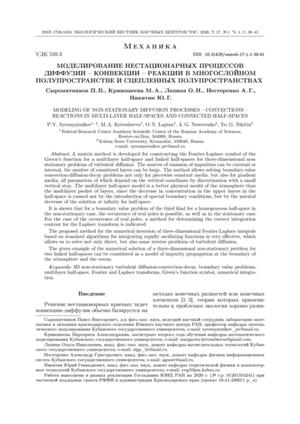Моделирование нестационарных процессов диффузии - конвекции - реакции в многослойном полупространстве и сцепленных полупространствах
УДК
539.3DOI:
https://doi.org/10.31429/vestnik-17-1-1-30-41Аннотация
Для многослойного полупространства разработан численно-аналитический матричный метод построения символа Фурье--Лапласа функции Грина для трехмерных нестационарных задач турбулентной диффузии с внешними или внутренними источниками. Метод позволяет решать краевые задачи не только для кусочно-однородных сред, но и для градиентных сред, параметры которых зависят от вертикальной координаты. В работе показано, что для краевой задачи третьего рода для однородного полупространства в нестационарном случае возможно возникновение вещественных полюсов у символа функции Грина, как и в стационарном. Для этого случая указан способ определения корректного контура интегрирования в преобразовании Лапласа. Метод численного обращения интегралов Фурье--Лапласа позволяет эффективно решать не только прямые, но и различные обратные задачи турбулентной диффузии. Приведен пример решения нестационарной пространственной задачи для двух сцепленных полупространств с источником на границе раздела.
Ключевые слова:
трехмерная нестационарная турбулентная диффузия-конвекция-распад, краевые задачи, многослойное полупространство, преобразования Фурье и Лапласа, символ функции Грина, численное интегрированиеИнформация о финансировании
Работа выполнена в рамках реализации Госзадания ЮНЦ РАН на 2020 г. (№ г.р. 01201354241) при частичной поддержке гранта РФФИ и администрации Краснодарского края (проект 19-41-230011 р_а).
Библиографические ссылки
- Бекман И.Н. Высшая математика: математический аппарат диффузии. М.: Издательство Юрайт, 2018. 397 с. [Beckman, I.N. Higher mathematics: the mathematical apparatus of diffusion. Yurayt Publishing House, Moscow, 2018. (In Russian)]
- Самарский А.А., Вабищевич П.Н. Численные методы решения задач конвекции-диффузии. М.: Книжный дом "Либроком", 2015. 248 с. [Samarsky, A.A., Vabishchevich, P.N. Numerical methods for solving convection-diffusion problems. Book House Librocom, Moscow, 2015. (In Russian)]
- Hundsdorfer W.H., Verwer J.G. Numerical solution of time-dependent advection-diffusion reaction equations. Springer, Berlin, 2003. 472 p.
- Эйдерман В.Я. Основы теории функций комплексного переменного и операционного исчисления. М.: ФИЗМАТЛИТ, 2002. 256 с. [Eiderman, V.Ya. Fundamentals of the theory of functions of a complex variable and operational calculus. FIZMATLIT, Moscow, 2002. (In Russian)]
- Международная библиотека математических подпрограмм IMSL URL: https://www.roguewave.com/products-services/imsl-numerical-libraries (дата обращения: 30.01.2020). [International library of mathematical routines IMSL. Available at: https://www.roguewave.com/products-services/imsl-numerical-libraries (accessed 01.30.2020).]
- The NAG Fortran Library, The Numerical Algorithms Group (NAG), Oxford, United Kingdom. URL: https://www.nag.com (дата обращения: 30.01.2020).
- Сыромятников П.В. Матричный метод решения нестационарных задач конвекции-диффузии в полуограниченных многослойных и градиентных средах // Наука Юга России. 2018. Т. 14. № 4. С. 3–13 DOI: 10.7868/S25000640180401 [Syromyatnikov, P.V. Matrichnyy metod resheniya nestatsionarnykh zadach konvektsii-diffuzii v poluogranichennykh mnogosloynykh i gradientnykh sredakh [The matrix method for solving unsteady convection-diffusion problems in semi-bounded multilayer and gradient media]. Nauka Yuga Rossii [Science of the South of Russia], 2018, vol. 14, no. 4, pp. 3–13. DOI: 10.7868/S25000640180401 (In Russian)]
- Сыромятников П.В., Кривошеева М.А., Лапина О.Н., Нестеренко А.Г., Никитин Ю.Г. Стационарные процессы диффузии-конвекции-распада в однородном полупространстве // Экологический Вестник научных центров Черноморского экономического сотрудничества. 2019. Т. 16. № 4. C. 31–42. DOI: 10.31429/vestnik-16-4-31-42 [Syromyatnikov, P.V., Krivosheeva, M.A., Lapina, O.N., Nesterenko, A.G., Nikitin, Yu.G. Statsionarnye protsessy diffuzii-konvektsii-raspada v odnorodnom poluprostranstve [Stationary processes of diffusion-convection-decay in a homogeneous half-space]. Ekologicheskiy Vestnik nauchnykh tsentrov Chernomorskogo ekonomicheskogo sotrudnichestva [Ecological Bulletin of the BSEC Scientific Centers], 2019, vol. 16, no. 4, pp. 31–42. DOI: 10.31429/vestnik-16-4-31-42 (In Russian)]
- Самарский А.А., Вабищевич П.Н. Численные методы решения обратных задач математической физики. М.: ЛКИ, 2009. 480 с. [Samarsky, A.A., Vabishchevich, P.N. Chislennye metody resheniya obratnykh zadach matematicheskoy fiziki [Numerical methods for solving inverse problems of mathematical physics]. LCI, Moscow, 2009. (In Russian)]
Скачивания

Загрузки
Даты
Поступила в редакцию
Принята к публикации
Публикация
Как цитировать
Лицензия
Copyright (c) 2020 Сыромятников П.В., Кривошеева М.А., Лапина О.Н., Нестеренко А.Г., Никитин Ю.Г.

Это произведение доступно по лицензии Creative Commons «Attribution» («Атрибуция») 4.0 Всемирная.


